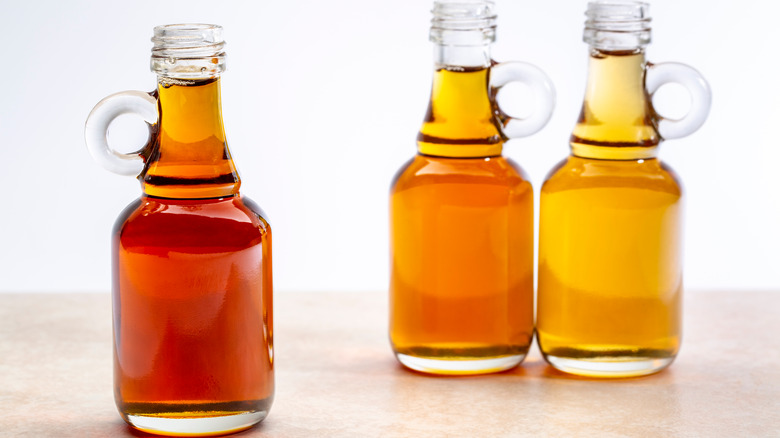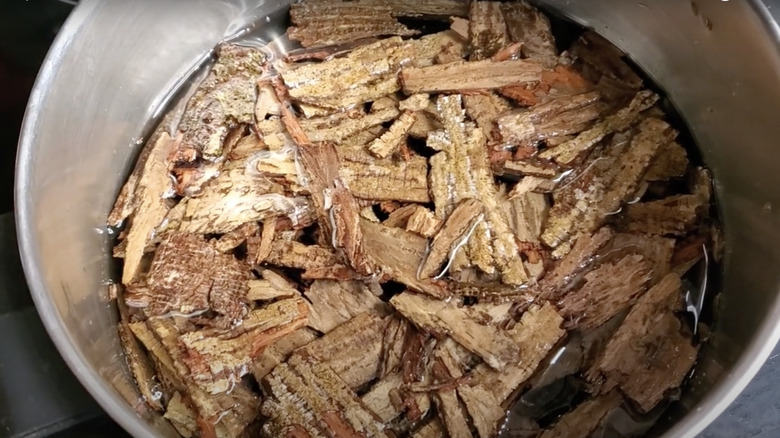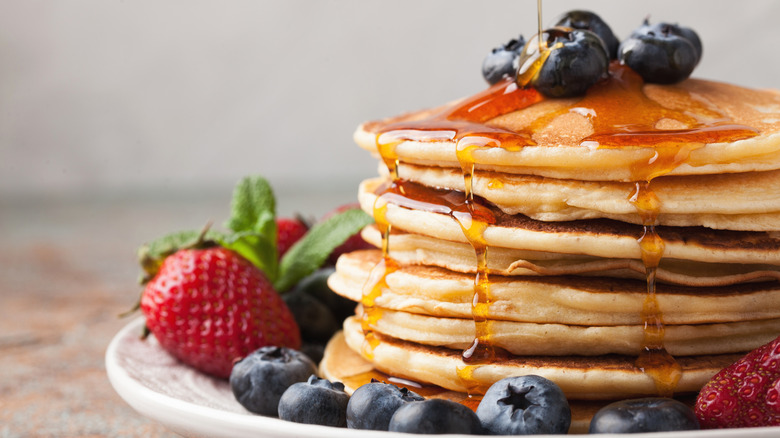Upgrade Your Breakfast With Smoky, Sweet Hickory Syrup
When it comes to your morning pancakes or French toast, which sweetener do you tend to grab to top the starchy goodness? Many will reach for the OG: maple syrup. Its complex, toasty flavors bring way more than sweetness to your stack. Others will opt for honey, whose range of aromas — from floral to fruity to herbaceous — also adds depth to breakfast. Still, others will choose other options such as agave nectar, brown rice syrup, fruit jam, or Nutella. Whatever your preference, there is bound to be a topping for you.
If this world of sweeteners isn't wide enough for you, you're going to want to look up hickory syrup. Also known as shagbark syrup, this less widely known sweetener can help you mix up your breakfast routine, bring sweetness to desserts, including ice creams and custards, help create glazes for meat and fish, and so much more. Here's the scoop on this intriguing, unusual syrup.
All about hickory syrup
Hickory syrup, as you may have figured out, comes from the hickory tree — more specifically, a variety known as shagbark, whose bark naturally begins to peel off in sheaths when the tree reaches maturity. These trees are native to the Eastern United States, with their range extending from eastern Texas to points both north and east of there. But if you're thinking hickory syrup derived from the tree's sap, as maple syrup is, you'd be wrong: It doesn't actually contain its own sweetener.
To make hickory syrup, the tree's bark is sustainably harvested, washed, roasted in the oven, and steeped to make tea. It is then strained and mixed with granulated sugar to make syrup. Boasting a smoky, campfire-like flavor owing to the step of roasting the bark, hickory syrup is sweet, yes, but contains plenty of toasty notes, as well. In recent years, many farmers markets in the Eastern U.S., particularly Virginia, where the trees abound, have started offering hickory syrup for sale. If you don't have one nearby, there are some websites where you can buy it, too.
How to make hickory syrup
If you live in a hickory-rich region, you may have already sampled the sweet stuff. But if you haven't and happen to live near a hickory forest, it's actually pretty simple to make at home. When they're around seven years of age, shagbark hickory trees naturally start to shed their bark, making it super-simple to snap right off the tree. For every pint of shagbark syrup, you'll want to harvest 4 ounces of bark; just be careful not to take too much from any one tree (and do check your state's local foraging laws at Forage Culture to make sure bark-gathering is fully above board).
At home, using bark that's relatively clean of moss and mold, you'll scrub the bark in a bowl of warm water, then let it soak for 15 minutes. You'll drain it, transfer it to a baking dish, and roast it at 400 degrees Fahrenheit for 25 minutes. Once it's cooled, you'll break it into smaller pieces, then simmer it with enough clean water to cover for about 30 minutes, making the shagbark "tea." You'll strain out the bark, then, in a saucepan, add 1 cup of sugar for every cup of tea, bring the mixture to 225 degrees Fahrenheit on a candy thermometer, then pour the hot liquid into clean glass jars and seal them. Hickory syrup will last a long time in the pantry, but be sure to refrigerate it after opening it to avoid spoilage.
How to use hickory syrup
As with other sweeteners, you'll find lots of uses for hickory syrup in your kitchen. It can be warmed and poured over breakfast treats such as pancakes, French toast, buttermilk biscuits, and crêpes, but its applications go far beyond that. Stir some hickory syrup into your coffee or tea for some toasty notes; tip some into long-cooking dishes like chili for depth of flavor; or use it to create sweet glazes for pork loin, salmon filets, or grilled chicken.
Hickory syrup makes a great alternative sweetener for desserts and can be used in recipes for ice cream, custards, and puddings. And if you've already got some ice cream on hand in the freezer, think of hickory syrup for topping it. "You put that on some vanilla ice cream, and you don't know what you've been missing," Beth Palmer of Sutton Mill Creek Syrup Co. told The Takeout.
Where to buy hickory syrup
If you don't live close to any hickory trees or simply aren't in the mood to forage for bark, there are plenty of online retailers offering hickory syrup for sale. Based in Bennington County, Vermont, Vermont Shagbark Syrup offers plain syrup in 12-, 8-, and 1.5-ounce bottles. The company also offers tea bags full of pure shagbark for making hickory tea (or your own homemade syrup). Highland County, Virginia's Back Creek Farms, too, sells plain syrup in 8-ounce bottles. And if you're looking for sweetness while supporting a historic landmark, you can even purchase the syrup from the website for Thomas Jefferson's Monticello.
Looking for some fun, inventive flavors of hickory syrup? Clarksville, Georgia's Sutton Mill Creek Syrup Co. stocks pecan, bourbon, spiced apple cider, and smoky maple varieties of shagbark syrup, while Clarke County, Virginia's Falling Bark Farm offers sassafras, woodland spice, brandy, and vanilla flavors. With all these purveyors, plus the option to make your own at home, there's simply no reason not to try some hickory syrup.




